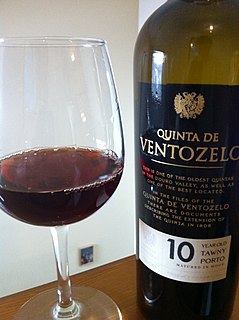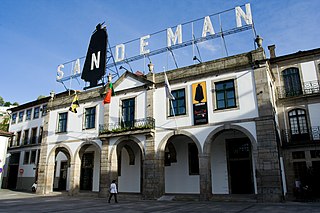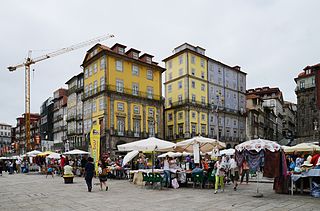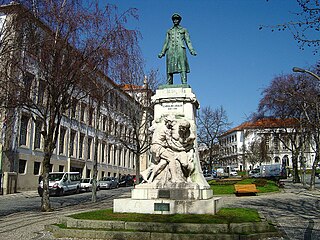This article is about the demographic features of the population of Portugal, including population density, ethnicity, education level, health of the populace, economic status, religious affiliations and other aspects of the population.

Miranda do Douro or Miranda de l Douro is a town and a municipality in the district of Bragança, northeastern Portugal. The population in 2011 was 7,482, in an area of 487.18 km². The town proper had a population of 1,960 in 2001. Referred to as the "Cidade Museu" of the Trás-os-Montes region, it is located 86 kilometres from Bragança, preserving many of its medieval and Renaissance-era traditions and architecture. It has a language of its own, Mirandese, which enjoys official status in Portugal, in addition to cultural and historical discontinuity with the rest of the Portuguese state. The town is located on the border with Spain, with the Douro River separating the two countries. The nearest town in Spain is Zamora.

Port wine is a Portuguese fortified wine produced in the Douro Valley of northern Portugal. It is typically a sweet red wine, often served as a dessert wine, although it also comes in dry, semi-dry, and white varieties.

The Mirandese language is an Astur-Leonese language or language variety that is sparsely spoken in a small area of northeastern Portugal in Terra de Miranda. The Assembly of the Republic granted it official recognition alongside Portuguese for local matters on 17 September 1998 with the law 7/99 of 29 January 1999. In 2001, Mirandese was officially recognised by the European Bureau for Lesser-Used Languages, which aims to promote the survival of the least spoken European languages.

Vila Nova de Gaia, or simply Gaia, is a city and a municipality in Porto District in Norte Region, Portugal. It is located south of the city of Porto on the other side of the Douro River. The city proper had a population of 178,255 in 2001. The municipality has an area of 168.46 km². and a total population of 302,295 inhabitants (2011), making it the most populous municipality in Norte Region. Gaia along with Porto and 12 other municipalities make up the commonly designated Porto Metropolitan Area.

Portuguese wine is the result of traditions introduced to the region by ancient civilizations, such as the Phoenicians, Carthaginians, Greeks, and mostly the Romans. Portugal started to export its wines to Rome during the Roman Empire. Modern exports developed with trade to England after the Methuen Treaty in 1703. From this commerce a wide variety of wines started to be grown in Portugal. And, in 1758, one of the first wine-producing regions of the world, the Região Demarcada do Douro was created under the orientation of Marquis of Pombal, in the Douro Valley. Portugal has two wine-producing regions protected by UNESCO as World Heritage: the Douro Valley Wine Region and Pico Island Wine Region. Portugal has a big variety of local kinds, producing a very wide variety of different wines with distinctive personality.

Bragança District is a traditional political division of Portugal, in the northeast corner bordering on Spain, covering 7.4% of the nation's continental landmass. The capital of the district, Bragança, is 217 kilometres (135 mi) from Porto, the second largest town in Portugal, 107 kilometres (66 mi) from the Spanish town of Zamora and 169 kilometres (105 mi) from Salamanca, also in Spain. Bragança is administratively divided in twelve municipalities and 299 parishes located in the north-eastern part of Trás-os-Montes. As of the 2011 census, the total resident population was approximately 136,252. It is bordered by Spain in the north and northeast, Vila Real District in the west, Viseu District in the southwest and Guarda District in the south.

Douro is a Portuguese wine region centered on the Douro River in the Trás-os-Montes e Alto Douro region. It is sometimes referred to as the Alto Douro, as it is located some distance upstream from Porto, sheltered by mountain ranges from coastal influence. The region has Portugal's highest wine classification as a Denominação de Origem Controlada (DOC). While the region is associated primarily with Port wine production, the Douro produces just as much table wine as it does fortified wine. The non-fortified wines are typically referred to as "Douro wines".

Grande Porto or Greater Porto is a former Portuguese NUTS3 subregion, integrating the NUTS2 region of Norte, in Portugal. It was abolished at the January 2015 NUTS 3 revision.

Tourism in Portugal serves millions of international and domestic tourists. Tourists visit to see cities, historic landmarks, enjoy beaches, or religious sites. As of 2019, Portugal had 27 million visitors. The most popular destinations were Lisbon, Porto, Algarve, the Portuguese Riviera, Madeira, Sintra, Óbidos and Fátima. The most popular with internationals were Lisbon, the Algarve and Northern Portugal. National tourists prefer Northern Portugal, followed by Central Portugal and the Algarve.

Sezão, formerly known as Souzão, is a Portuguese wine grape that is used in the production of port wine and table wines.

Avintes is a Portuguese civil parish in the municipality of Vila Nova de Gaia. The population in 2011 was 11,497, in an area of 8.82 km².

The Ribeira Square is a historical square in Porto, Portugal. It is included in the historical centre of the city, designated World Heritage by UNESCO.

Vila Real is the capital and largest city of the Vila Real District, northern Portugal. The population in 2011 was 51,850, in an area of 378.80 square kilometres (146.26 sq mi).

The Fountain of Passeio Alegre is a fountain located in civil parish of Aldoar, Foz do Douro e Nevogilde, municipality of Porto in northern Portugal.
Douro Film Harvest is the first totally decentralized international summit of cinema, that takes place in Alto Douro Wine Region,a area classified by UNESCO as World Heritage Patrimony and homeland of Porto Wine.
Donzelinho branco is a white Portuguese wine grape variety that is classified as one of the "Very Good" varieties authorized to be used in Port wine production. While rarely seen as a varietal wine, Donzelinho branco is a permitted variety in the white blends of several northern Portuguese wine regions including the Denominação de Origem Controlada (DOC) of Douro and Trás-os-Montes and the Vinho Regional (VR) wines of Duriense and Transmontano.
The Castle of Alva is a medieval castle located in the civil parish of Viade de Baixo e Fervidelas, in the municipality of Freixo de Espada à Cinta, Portuguese district of Bragança.















